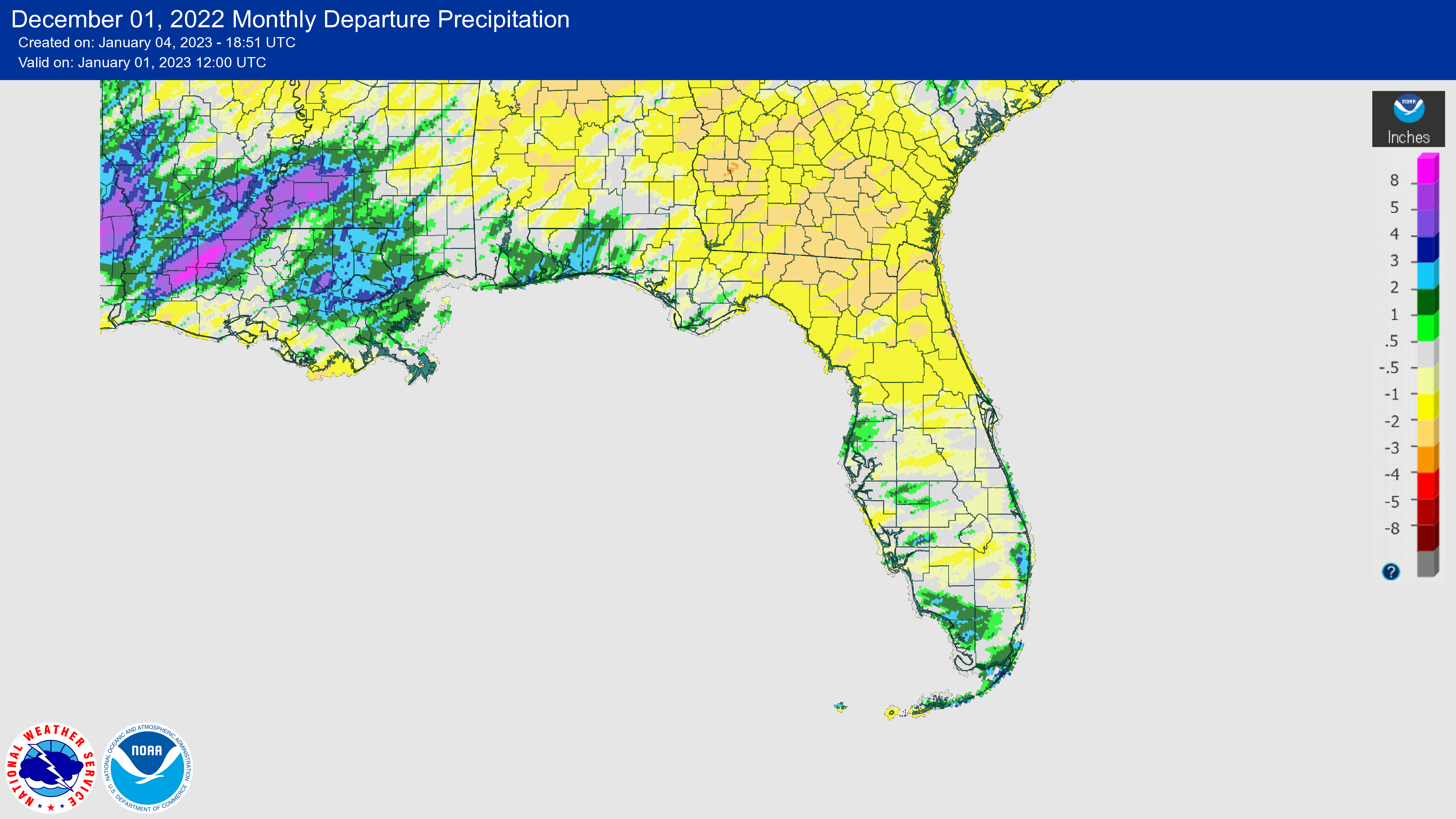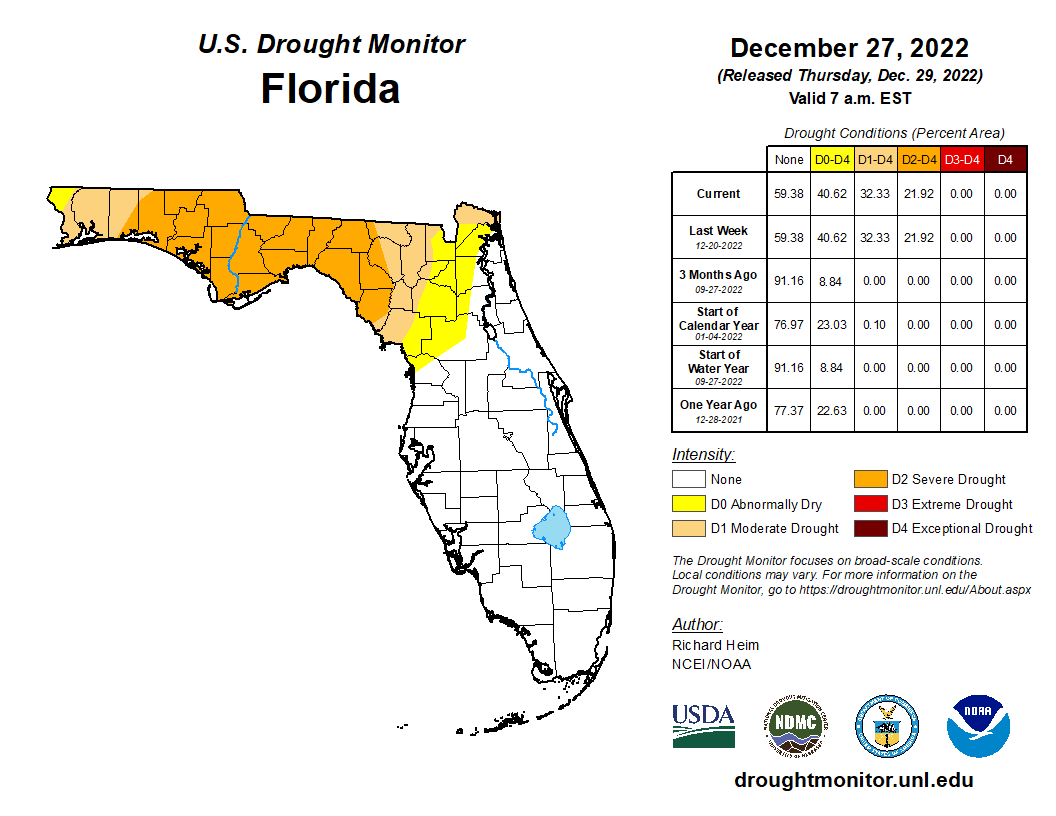Prepared by Florida Climate Center
The Florida State University
Tallahassee, FL
Key Points:
- With wide temperature swings throughout the month of December, monthly average temperature departures ended up near normal across the state.
- Monthly precipitation for December was generally below normal, with exceptions in the western Panhandle and southern Peninsula.
- Drought conditions persisted across the Panhandle throughout the month, and about 32% of the state remains in severe (D2) or moderate (D1) drought as of the end of December.
- We are in the third winter in a row with La Niña conditions in the equatorial Pacific Ocean, though chances for a transition to ENSO-neutral increase to 71% during February-April 2023.
December brought large swings in temperature but, overall, the average monthly temperatures in December were near to above normal across the state. Average temperature departures from normal ranged from -1.3 ̊F in Melbourne to +2.7 ̊F in Pensacola for the month (see Table 1 and Appendix 1 for select cities). The month started out warmer than normal, with record warm temperatures across the Panhandle during the first half of the month. A shift in the weather pattern brought a return to more seasonal temperatures mid-month, while the last week of December was much colder than normal. Many locations experienced frigid temperatures on the order of 20 ̊F or more below normal during the last week of December, including over Christmas. Many places in the Panhandle saw minimum temperatures in the teens, with wind chills in the single digits, including Tallahassee, which reached a low of 19 ̊ F and 18 ̊ F on the 25th and 26th, respectively; Crestview recorded a low of 18 ̊ F on the 24th; and Niceville got down to 17 ̊ F on the 24th and 25th. Select daily high maximum and low minimum temperature records tied or broken during the month are provided in Appendices 2 and 3, respectively.
Table 1. December average temperatures and departures from normal ( ̊F) for selected cities.
| Station | Mean Temperature | Departure from Normal |
| Pensacola | 58.2 | +2.7 |
| Tallahassee | 55.9 | +1.5 |
| Jacksonville | 56.3 | -0.4 |
| Orlando | 64.2 | +0.9 |
| Tampa | 64.7 | -0.2 |
| Miami | 72.3 | +1.1 |
| Key West | 73.5 | +0.5 |
Monthly rainfall totals in December were below to near normal for much of the state. The monthly precipitation departures from normal ranged from -2.53 inches in Jacksonville to +2.02 inches in Key West (see Table 2 and Appendix 1 for additional locations). Over the past three months, below normal rainfall has led to precipitation deficits across the Panhandle and north Florida and the expansion of drought.
Table 2. December precipitation totals and departures from normal (inches) for selected cities.
| Station | Total Rainfall | Departure from Normal |
| Pensacola | 5.61 | +0.21 |
| Tallahassee | 2.09 | -2.15 |
| Jacksonville | 0.25 | -2.53 |
| Orlando | 0.95 | -1.53 |
| Tampa | 2.35 | -0.21 |
| Miami | 1.73 | -0.71 |
| Key West | 4.18 | +2.02 |
Figure 1. A graphical depiction of the monthly rainfall departure from normal (inches) for December (courtesy of NOAA, NWS).

La Niña Advisory.
La Niña is expected to continue into the winter, but there are equal chances of La Niña and ENSO-neutral conditions during January-March 2023. In February-April 2023, the chance for ENSO-neutral conditions increases to 71%, reflecting higher confidence that ENSO-neutral will emerge during Spring 2023. Below-average sea surface temperatures persisted in the central and eastern Pacific Ocean over the past month, but negative subsurface temperature anomalies weakened in November 2022.
Hazardous Weather Events in December.
According to the Local Storm Reports issued by the local National Weather Service offices serving Florida, there were 111 individual local reports of hazardous weather events recorded across the state during the month of December (see Table 4 for a breakdown by event type). There were several reports of damage from strong wind gusts during the middle and end of the month, along with waterspouts and tornados reported in the central Panhandle area on the 14-15th.
Table 4. Breakdown of storm reports submitted in Florida during the month of December (compiled from Iowa State University/Iowa Environmental Mesonet).
| Report Type | Number of Reports |
| Heavy Rain | 9 |
| Flood | 0 |
| Coastal Flood | 1 |
| Hail | 1 |
| Marine Thunderstorm Wind | 21 |
| Non-Thunderstorm Wind Gust | 32 |
| Non-Thunderstorm Wind Damage | 3 |
| Tornado/Waterspout/Funnel Cloud | 9/5/2 |
| Thunderstorm Wind Damage | 11 |
| Thunderstorm Wind Gust | 13 |
| Rip Currents | 3 |
| Sleet | 1 |
Daily Record Events in December.
Table 5.Summary of daily records broken or set in Florida in December (source: NCEI Daily Weather Records).
| Category | Number of Records |
| Highest daily max. temp. | 20 |
| Highest daily min. temp. | 15 |
| Lowest daily max. temp. | 38 |
| Lowest daily min. temp. | 13 |
| Highest daily precipitation | 5 |
| Total | 91 |
Weather/Climate Highlight of the Month:
It was a very cold but dry Christmas across Florida – nearly every station in the state recorded one of their top 5 coldest Christmases on record, based on daily average temperatures.
Drought-Related Impacts.
By the middle of December, severe drought had expanded across the Panhandle and extended east to parts of Hamilton, Suwannee, and Dixie counties. About 26% of the state was in severe drought (D2) and 6% was in moderate drought (D1), according to the U.S. Drought Monitor. By the end of the month, 22% of the state was in severe drought (D2), 10% was in moderate drought (D1), and 8% was abnormally dry (D0) (Figure 2 below).
As of December 31, the Lake Okeechobee water level was 16.36 ft. above sea level (Feet-NGVD29), which is above average for this time of the year. At the first of the month, the water level was 16.48 ft. above sea level.
Figure 2. A graphical depiction of the current drought conditions in Florida according to the U.S. Drought Monitor (courtesy of the National Drought Mitigation Center, University of Nebraska-Lincoln).

Agriculture-Related Impacts.
During the month of December, Florida pasture conditions were mostly fair to good but the cold spell at the end of the month led to damage to pastures across the state. There were some reports of cattle deaths due to the cold spell. Little precipitation fell during the month, which worsened drought conditions in the northern part of the state. Sugarcane planting and harvest progressed well during the month, and citrus crops not damaged by the hurricanes in the fall were shipped out. Several vegetable crops were planted and harvested. For more information, consult the Crop Progress - State Stories reports, which are produced monthly December through March by the USDA’s National Agricultural Statistics Service.
Appendix 1
Additional December departures from normal data for select Florida locations (Source: NWS).
| Station | Average Temperature (˚F) | Departure from Normal (˚F) | Total Rainfall (in.) | Departure from Normal (in.) |
| Gainesville | 57.7 | +0.4 | 1.64 | -1.24 |
| Sarasota | 65.1 | -0.1 | 2.63 | +0.30 |
| Melbourne | 64.9 | -1.3 | 2.30 | -0.06 |
| Fort Myers | 68.8 | +1.5 | 1.10 | -0.80 |
| West Palm Beach | 70.2 | +1.8 | 3.51 | +0.03 |
Appendix 2
Select daily record high maximum temperatures (°F) broken or tied during December (compiled from NOAA).
| Location | Date | Record | Broken/Tied | Last |
| Fort Lauderdale Beach | 1 | 85 | Tied | 85 in 2020 |
| Key West | 1 | 89 | Broken | 85 in 2019 |
| Key West | 3 | 88 | Broken | 87 in 1994 |
| Key West | 6 | 89 | Broken | 86 in 1994 |
| Marianna | 7 | 82 | Broken | 80 in 2004 |
| Crestview | 7 | 84 | Broken | 83 in 1951 |
| Pensacola | 7 | 81 | Broken | 80 in 1951 |
| Niceville | 8 | 81 | Broken | 79 in 1951 |
| Pensacola | 8 | 81 | Broken | 80 in 1998 |
| Tallahassee | 8 | 82 | Broken | 81 in 2013 |
| Cross City | 10 | 85 | Broken | 82 in 2013 |
| Key West | 11 | 88 | Broken | 87 in 2021 |
| Key West | 30 | 89 | Broken | 86 in 2021 |
| Vero Beach | 31 | 87 | Broken | 85 in 2021 |
Appendix 3
Select daily record low minimum temperatures (°F) broken or tied during December (compiled from NOAA).
| Location | Date | Record | Broken/Tied | Last |
| Marianna | 23 | 21 | Broken | 23 in 2000 |
| Fort Lauderdale | 24 | 45 | Broken | 50 in 2012 |
| Niceville | 24 | 17 | Broken | 20 in 1960 |
| Tarpon Springs | 24 | 24 | Broken | 25 in 1906 |
| Marianna | 24 | 17 | Broken | 29 in 2005 |
| Cross City | 24 | 22 | Broken | 24 in 2010 |
| Orlando | 24 | 30 | Broken | 36 in 1963 |
| Daytona Beach | 25 | 28 | Broken | 31 in 1961 |
| Marianna | 25 | 19 | Broken | 28 in 2020 |
| Cross City | 25 | 19 | Broken | 27 in 2020 |
| Orlando | 25 | 28 | Broken | 31 in 1963 |
| Daytona Beach | 26 | 29 | Tied | 29 in 1963 |
| Wewahitchka | 26 | 17 | Tied | 17 in 1985 |
| Marianna | 26 | 18 | Broken | 25 in 2020 |
| Cross City | 26 | 20 | Broken | 22 in 2020 |


